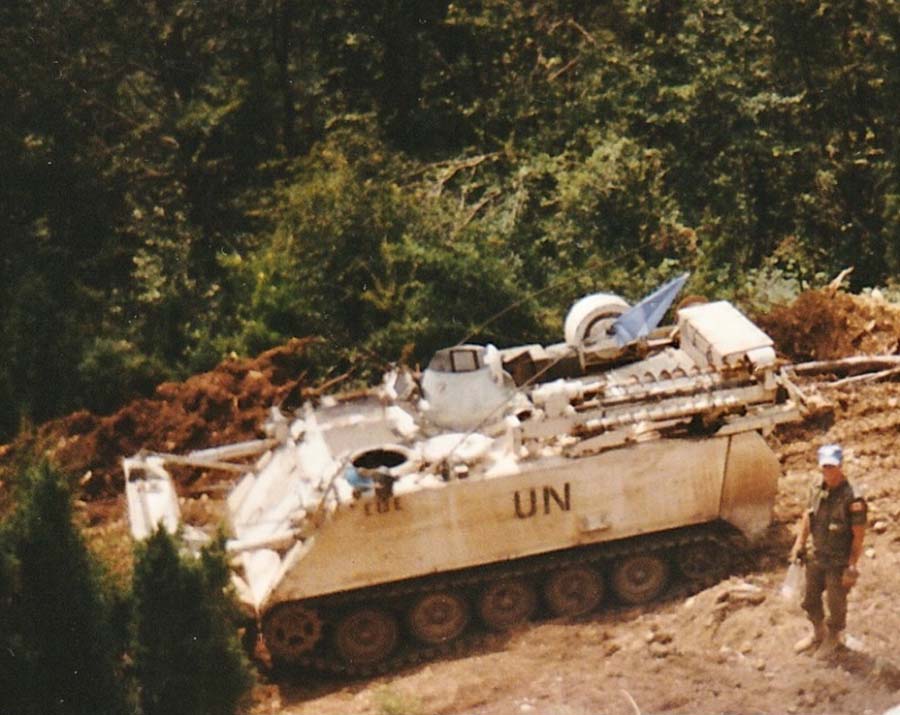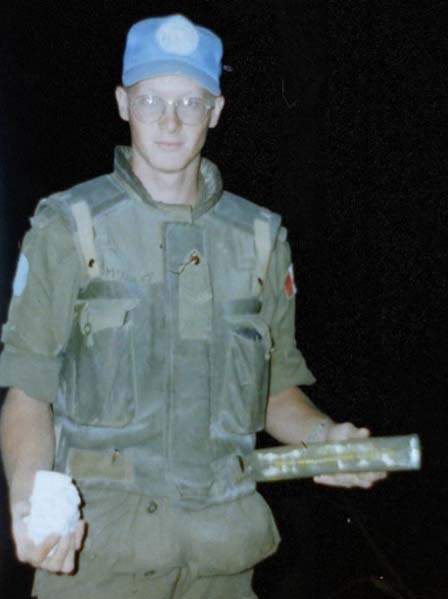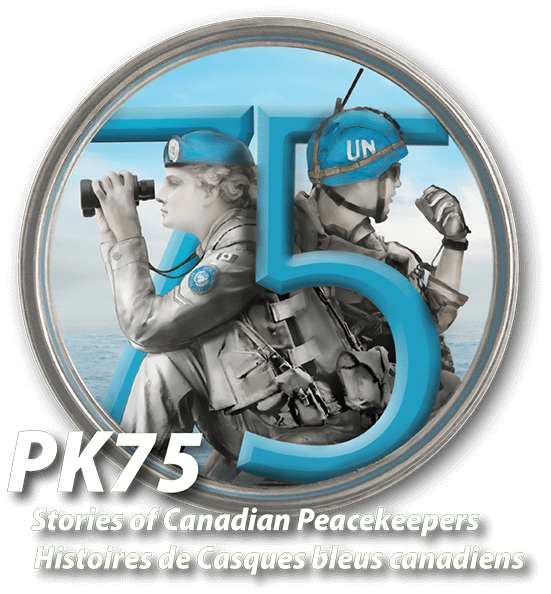

Cochrane, AB, Canada
William (Bill) McAuley
Current Location: Calgary, AB, Canada
One of the certainties of all peacekeeping operations is the persistent need for engineering services. Humanitarian convoys can’t move unless destroyed bridges are replaced and mountain tracks are turned into highways to bypass active fighting. Hospitals, power grids, and water systems supporting civilian populations all suffer collateral damage or break down from neglect. Peacekeepers also need to build and sustain the equivalent of small towns for their own contingents. Observation posts situated between warring factions need to be cleared of landmines and fortified to protect against artillery, mortar, and machine gun fire. Images of peacekeeping missions rarely portray the shovels, hammers, chainsaws, sandbags, mine detectors, dump trucks, bulldozers, cranes, and rockdrills that enable the daily wizardry of engineering units. Engineer contingents are the humble workhorses of every peacekeeping mission.
From May to October 1994, I was part of a sub-unit of 1 Combat Engineer Regiment (1 CER) supporting the Lord Strathcona Horse (Royal Canadians) Battle Group of the United Nations Protection Force (UNPROFOR) in Bosnia Herzegovina. With just 74 members, our sub-unit made a disproportionate impact from our base in Visoko. Key accomplishments of 17 Engineer Squadron included: over 65 km of roads repaired or constructed; over 22,000 cubic metres of gravel hauled; 1.3 million litres of water purified; 25 observation posts (OPs) and road checkpoints (CPs) constructed or improved; over 70,000 sandbags placed; and approximately 27 km of minefields in mountainous terrain cleared.
At 19-years-old, I was probably the youngest member of the Battle Group and one of only five army reservists within the engineer contingent. I was the junior sapper (the traditional rank of an engineer private) of a field engineer section and was often the ‘preferred volunteer’ for any dirty jobs, such as sandbagging the exposed roof of an OP while being harassed by bemused snipers of the warring factions. My days generally involved endless hours of hard manual labour, but there was fulfillment in knowing this work was helping humanitarian convoys move supplies and restore lifeline services to civilians. There was also the noticeable respect that our hard work garnered within the Battle Group as our grimy M113 Section Engineer Vehicle (SEV) — a mobile workshop that looks like a Swiss army knife on tracks because it bristles with an earth auger, hydraulic tools, innumerable tool boxes, and a dozer blade — arrived at remote mountain outposts to build literal castles out of sea containers, 12×12 timbers, sandbags, and Hesco bastion blast walls. Interspersed were unique tasks such as midnight blasting of rockfaces on mountain switchbacks with C4 explosives to enable aid convoys destined for the besieged Sarajevo to traverse a former goat track dubbed Route PACMAN.
One of the more dangerous tasks we did during the summer of 1994 was monitoring the removal of landmines in the densely forested hills around the town of Kiseljak. Each day we would wind our way through trench systems alongside engineers from the warring factions. With an unfathomable lack of concern for safety, and without interruption to chain-smoking habits, these local engineers would crash through the undergrowth into no-mans-land to a location indicated on their dubious mine records and proceed to disarm and remove various improvised fragmentation mines. In many cases the mines had already been detonated during fighting or had at some point been clandestinely stolen by the opposing warring faction. Our job was to verify the clearance and provide immediate rescue and medical support should something go wrong.
While our rescue services were luckily never required, the deadly significance of mine clearance operations had resonance for us. Master Corporal Mark “Izzy” Isfeld, a member of our sister engineer contingent deployed in nearby Croatia, had been killed in June 1994 during a mine clearance operation. While unknown to me at the time, mines would become a core focus of my subsequent peacekeeping mission to Sarajevo in 2000, where I worked coordinating post-war mine threat information and assisting with developing Bosnia’s mine and unexploded ordinance clearance capabilities. The legacy of my 1994 tour in the Former Yugoslavia would also visibly touch my subsequent deployments to Afghanistan, where we would give “Izzy Dolls” to children in honour of the sacrifice of Canadian peacekeepers.
Biography
Bill McAuley joined the Canadian Armed Forces as a part-time soldier (a.k.a. reservist) in Calgary on 10 October 1992 at the age of 17. After initial training as a sapper (a.k.a. combat engineer) in Chilliwack B.C., he quickly volunteered for United Nations’ peacekeeping duties in Bosnia Herzegovina as a reserve augmentee. In 1994, Bill deployed to Camp Visoko in Bosnia with 1 Combat Engineer Regiment as part of the Lord Strathcona Horse (Royal Canadians) Battle Group. This mission placed a young sapper in his element, with rewarding days of honest physical labour fortifying remote observation posts, repairing critical humanitarian supply routes, assisting with landmine clearance, and maintaining essential camp services. Bill subsequently returned to his civilian university studies, paying for his entire education through his part-time military service by attending military qualification courses and eventually instructing at the Canadian Forces School of Military Engineering (CFSME) during summer breaks.
Bill returned to peace enforcement duties in Bosnia in 2000, this time with the North Atlantic Treaty Organization (NATO) Stabilization Force (SFOR) that was helping maintain the peace so that reconstruction efforts could proceed. While the war had ended, landmines and unexploded ammunition still littered much of the country. Now a Sergeant, Bill worked in downtown Sarajevo with the Mines Information Coordination Cell (MICC) focussing on preventing casualties from landmines and supporting the development of local capabilities to clear the extensive landmine and explosive threat to civilians.
Bill’s army reserve training and peacekeeping experience in Bosnia set him up nicely for an initial civilian career as an Explosives Inspector with the Government of Canada. Having also progressed quickly through the ranks of Calgary’s reserve engineer unit, 33 Field Engineer Squadron, Bill also sought out additional challenges through specialized training in military intelligence and a graduate degree in military and strategic studies. In 2004, now holding the rank of Warrant Officer, Bill volunteered to deploy to Kabul, Afghanistan in a specialized intelligence role. While Afghanistan was not a peacekeeping mission, Bill’s experiences in Bosnia still provided a strategic advantage. Becoming a commissioned officer in 2005, Bill would return to Afghanistan in 2008 in command of a specialized intelligence team in Kandahar.
In 2010, Bill was inducted as a Member of the Order of Military Merit (MMM) and was convinced by distinguished Canadian military historian Dr. David Bercuson, to pursue a doctorate degree in strategic studies at the Centre for Military, Security and Strategic Studies (CMSS) in Calgary, which he completed while working fulltime, maintaining army reserve duties, and starting a family. Bill’s multi-disciplinary background in military engineering, military intelligence, and strategic studies eventually led him to transition to a second civilian career in public security with the Government of Alberta. Having gained priceless skills and experience during his 22 years of army reserve service, Bill retired from the Canadian Armed Forces in 2015 to focus on his growing family and increasing pressures of his civilian career.
Bill lives in Calgary with his wife and two children.

Corporal Greg Purcell stands next to the M113 Dozer Call Sign Echo-13-Echo (E13E) during construction of Observation Post Kilo-Hotel (OP KH). Kiseljak Pocket. August 1994.

Sapper Bill McAuley prepares C4 explosives charges for nighttime rock blasting on main supply route PACMAN between Blinje to Kresevo. 14 September 1994. Engineer work occurred from 2000-0530 hrs to allow vital humanitarian convoy traffic to use PACMAN during daylight hours.


